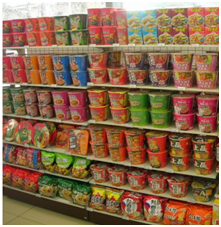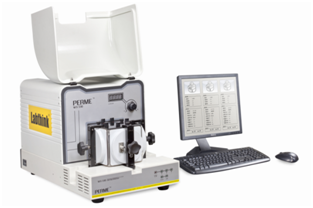Abstract: The moisture barrier performance of instant noodle barrels has an important impact on the quality of instant noodles during the shelf life. In this paper, a method for testing the moisture permeability of instant noodle barrels produced by a company is introduced. A method for testing the moisture resistance of instant noodle barrels is introduced, and the test principle and testing equipment W3/330 water vapor transmission rate test system are adopted. The introduction of parameters, scope of application, and test procedures provide a reference for enterprises to detect the moisture barrier performance of instant noodle barrels.
Key words: instant noodles, instant noodle barrel, water vapor transmission rate, water vapor transmission rate test system, moisture resistance, moisture resistance, softening, mildew
1, meaning
Instant noodles are a common instant noodle. At present, the main packaging methods include bagging, barreling and cupping. They are mostly fried and non-fried. These two forms of instant noodles have low moisture content in a humid environment. In the middle, the cake is easy to soften, and at the same time, it creates conditions for the reproduction of microorganisms, which is easy to cause mildew on the cake. This requires that the packaging of instant noodles should have high moisture resistance to ensure that the cake is in a dry environment. China is a large instant noodle production and sales country. According to statistics, domestic instant noodles production accounts for 1/2 of the world's total output, and consumption accounts for one-third of the world's consumption. Especially during the holiday visits and tourism, almost all kinds of instant noodles can be seen everywhere. Such a large market provides a broad space for development. However, if the above-mentioned quality problems such as softening and mildew occur during the warranty period, the economic losses and impacts on the enterprise are immeasurable. Therefore, It is necessary to strengthen the detection of the moisture resistance of instant noodle packaging.

Figure 1 An array of instant noodles
2, test samples
The text is taken as a test sample by a instant noodle barrel produced by a company.
3. Testing basis
At present, the water vapor transmission rate test methods mainly include cup method, electrolysis method, infrared method and humidity method. The water vapor transmission rate of the sample is tested by electrolysis method. The test basis is GB/T 21529-2008 "Plastic film and Determination of water vapor transmission rate of flakes Electrolytic sensor method, which is suitable for rapid determination of water vapor transmission rate of plastic films, sheets and multilayered structural materials containing plastics.
4, testing equipment
The test equipment used in this test is the W3/330 water vapor transmission rate test system, which is independently developed and produced by Jinan Languang Electromechanical Technology Co., Ltd.

Figure 2 W3/330 water vapor transmission rate test system
4.1 Test principle
The electrolytic sensor method calculates the water vapor transmission rate of the sample by analyzing the magnitude of the electrolysis current generated by the electrolyzed water molecules. The specific process is as follows:
The permeation cell of the device is divided into upper and lower test chambers, and the sample is clamped between the two test chambers. The upper chamber is filled with nitrogen gas of a certain humidity, and the lower chamber is dried nitrogen, so that a certain humidity is generated on both sides of the sample. Poor, water vapor permeates from the high-humidity side to the low-humidity side through the sample, and the low-humidity side nitrogen carries the permeated water vapor to the electrolysis sensor, and calculates the unit time by analyzing the electric signal generated by electrolysis of the water vapor of the electrolysis sensor. The amount of water vapor permeating through the sample per unit area, that is, the water vapor transmission rate.
4.2 Scope of application
(1) This equipment is suitable for testing the water vapor transmission rate of packaging materials such as film, sheet, paper, cardboard and composite materials, containers and the like. The film includes various plastic film, paper-plastic composite film, co-extruded film, aluminized film, aluminum foil, glass fiber aluminum foil paper composite film, etc.; sheet materials include various engineering plastics, rubber, building materials and other sheet materials, such as PP sheet, PVC sheet, PVDC sheet, etc.; paper, cardboard and composite materials including paper, cardboard, etc., such as cigarette coated aluminum paper, paper aluminum-plastic composite sheet, etc.; containers include plastic, rubber, paper Water vapor transmission rate test of bottles, bags, cans, boxes and barrels made of paper-plastic composite, glass, metal, etc., such as Coke bottles, peanut oil drums, Tetra Pak packaging, vacuum packaging bags, metal packaging bags, metal Three-piece cans, plastic cosmetic hose packaging, toothpaste hose packaging, jelly cups, etc.
In addition, through special configuration, the device can also be used for the water vapor transmission rate of special packaging parts such as medical blister, pharmaceutical plastic bottle, instant noodle bowl (barrel), paper cup, paper bowl, automobile fuel tank, battery plastic case, etc. test.
(2) This equipment complies with national and international standards such as GB/T 21529, ISO 15106-3, DIN 53122-2, YBB00092003.
Device parameters
The test range of film samples is 0.001 ~ 40 g / (m2 · 24h), the resolution is 0.001 g / (m2 · 24h); the test range of container samples is 0.0001 ~ 0.2 g / (pkg · 24h), the resolution The rate is 0.00001 g / (pkg · 24h); the test temperature range is 15 ° C ~ 55 ° C, the temperature control accuracy is ± 0.1 ° C; the humidity range is 0% RH, 35% RH ~ 90% RH, 100% RH, control The wetness accuracy is ±1%RH; the equipment is equipped with three test chambers, and the three test chambers can be designed independently. The test process does not interfere with each other, and the test results are displayed independently. The system can support up to 10 instruments in parallel connection and establish 30 tests. Efficient system for simultaneous testing; standard membranes for system calibration to ensure the accuracy and versatility of the test data; can be combined with the oxygen transmission rate test system to form a hybrid test system, controlled by a computer to achieve water vapor Efficient and convenient test method for simultaneous oxygen transmission rate testing.
5, the test process
5.1 Cutting
Use a special sampler to cut 3 pieces of the sample from the surface of the instant noodle barrel sample to be tested, and clamp the sample on the three test chambers of the device, and tighten the test cavity.
5.2 Testing
Set parameter information such as sample name, test temperature, test humidity, etc. Click the test option and the test starts. The pressure of the nitrogen gas is adjusted to bring the humidity in the test chamber to a set value, and the nitrogen flow rate adjustment knob is used to make the nitrogen flow rate in the upper and lower chambers reach the standard value.
5.3 Results
During the test, the instrument automatically records the change of water content in the low-humidity side. After the test, the test results are automatically calculated and displayed.
6, the results
The water vapor transmission rate test values ​​of the instant noodle barrel samples tested in this test were 10.336 g/(m2·24h), 10.806 g/(m2·24h), 11.075 g/(m2·24h), and the average value was 10.739 g/( M2·24h).
7. Conclusion
Water vapor transmission rate is an important aspect of the quality monitoring of instant noodle barrel. This performance has an important influence on the quality of the packaged instant noodles during the shelf life. This paper uses the principle of electrolytic sensor principle equipment W3/330 water vapor transmission rate test system for instant noodle barrel samples. The water vapor transmission rate is detected, the operation of the device is simple, the test efficiency is high, and the sample results are reproducible, which can truly reflect the moisture resistance of the tested sample. Labthink is a high-tech enterprise specializing in the production, research and development and testing services of packaging inspection equipment. It is committed to providing professional, accurate and high-end packaging inspection equipment and efficient and intimate packaging inspection services to customers all over the world. Testing equipment and services include barrier properties, tensile properties, composite fastness, heat sealability, tear properties, friction coefficient, solvent residue, total migration (evaporation residue) of oxygen, water vapor, nitrogen, carbon dioxide, etc. And so on the full range of performance of food packaging, understand the relevant information you can visit. The more you understand, the more trust! Jinan Languang Electromechanical Technology Co., Ltd. looks forward to enhancing technical communication and cooperation with enterprises and institutions in the industry!
Flexible Slient House,Office Cube Isolation Booth,Sound Insulate Meeting Booth,Noise Reduce Movable Silence Booth
Guangzhou Mingli Intelligent Equipment Co.,Ltd , https://www.minglibooth.com